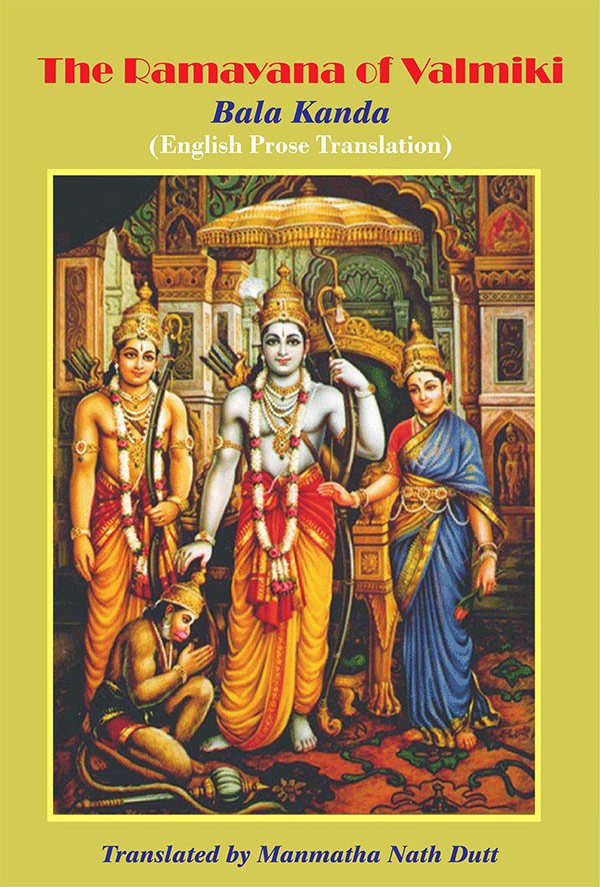Ramayana of Valmiki
by Hari Prasad Shastri | 1952 | 527,382 words | ISBN-10: 9333119590 | ISBN-13: 9789333119597
This page is entitled “the city of ayodhya” and represents Chapter 6 of the Bala-kanda of the Ramayana (English translation by Hari Prasad Shastri). The Ramayana narrates the legend of Rama and Sita and her abduction by Ravana, the king of Lanka. It contains 24,000 verses divided into seven sections [viz., Bala-kanda].
Chapter 6 - The city of Ayodhya
There dwelt in that city, King Dasaratha, a follower of the tradition of the illustrious Emperor Manu. The king was learned in the interpretation of the Vedas, his chief wealth was pre-eminence in truth and virtue; he was one who never broke his word, who was ever prudent, majestic and beloved of his subjects, a great charioteer, a worthy descendant of the dynasty of Ikshvaku, an observer of many sacrifices, one who ever delighted in the practice of righteousness; in full authority over his people, equal to a great sage; a royal seer, renowned in the three worlds, triumphing over his enemies, a friend to all; having perfect control of his senses and appetites; in prosperity equal to Indra; in wealth equal to Kuvera.
That truth-loving monarch, striving to acquire perfection in virtue, worldly prosperity and happiness, ruled the city as the celestial monarch Indra rules Amaravati.
The people in that city were happy, virtuous, learned, experienced, each satisfied with his state, practising his own calling, without avarice and of truthful speech. None was indigent or dwelt in a mean habitation; all lived happily with their families, possessing wealth, grain, cattle and horses. In that city of Ayodhya, none was a miser or a swindler, none was mean-spirited, proud, rash, worthless or an atheist. Men and women were of righteous conduct, fully self-controlled, and in their pure and chaste behaviour they equalled the great sages. None lacked earrings, coronets and necklaces. They bathed daily and rubbed their bodies with oil, using attar of roses and sandal paste. None ate impure food, none allowed his neighbour to suffer hunger. All possessed ornaments and gold, and there was none who had not learnt to subdue his mind. No one in the city neglected to offer butter and fragrant objects in the sacrificial fire. No one was mean, impious or failed to discharge his duties; there were no thieves and none were born of mixed castes.
The brahmins were devoted to their respective duties, firm in self-control and authorized to accept gifts. None denied the existence of God, none uttered falsehood or were enamoured of worldly pleasure and none was guilty of slander. No brahmin was unversed in the six systems of philosophy nor did any neglect to fast at the full moon, or on other appointed days; there were none who suffered from mental or physical infirmities and none were unhappy in that city.
Among the inhabitants, there were no revolutionaries and none who were not loyal to king and state. Those who dwelt there, worshipped the gods and the uninvited guest; they were both magnanimous and charitable.
All attained a ripe age as virtuous and truth-loving people; their homes were filled with children, grandchildren and virtuous women. The warriors were subject to the learned brahmins and the merchants to the warrior caste; in accordance with their caste the people served the brahmins, the warriors and the merchants.
In the administration of the empire, the Emperor Dasaratha followed the example of the first ruler Manu who was supreme in wisdom and a god among men.
Ayodhya abounded in warriors, undefeated in battle, fearless and skilful in the use of arms, resembling lions guarding their mountain caves.
There were horses in the city from Kamroja, Vanaya, Nudi and Vahli, and elephants from the regions of Vindhu and Himavat.
The city of Ayodhya was full of courageous and noble men belonging to the races of Bhadra, Mulla and Mriga, inhabitants of the regions of Bincyachala and the Himalayan ranges.
The city possessed mighty elephants like great hills. That capital was truly worthy of the name ‘Ayodhya,’ which means “The city none can challenge in warfare”.
Dwelling there, the Emperor Dasaratha, ruling the kingdom, resembled the moon in the midst of countless stars. That great king, equal to Indra himself, reigned over the city, guarded by fortifications and ramparts, a city which contained innumerable dwellings of many kinds and thousands of prosperous inhabitants.
